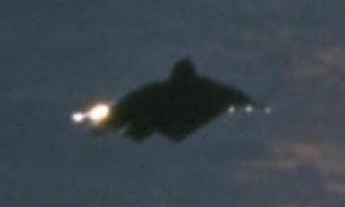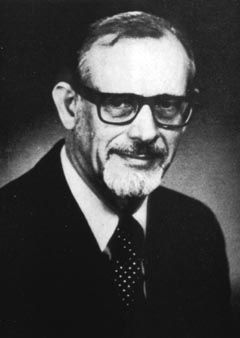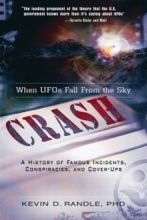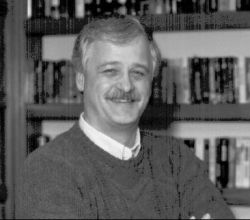
Publisher:
Bonnie King
CONTACT:
Newsroom@Salem-news.com
Advertising:
Adsales@Salem-news.com

~Truth~
~Justice~
~Peace~
TJP
Jun-14-2010 16:45

 TweetFollow @OregonNews
TweetFollow @OregonNews
The Flying Saucer Crashes
By Kevin D. Randle Ph.D. Special to Salem-News.comIn this case, the official sources are too busy explaining why this is impossible rather than attempting to learn if it is true.
 NASA Website photo of an undefined aircraft. |
(CEDAR RAPIDS, Iowa) - In 1950, a columnist for Variety, Frank Scully, published a book entitled, Behind the Flying Saucers. It was an expose of a government program, funded in secret and retaining some 1800 scientists, to study the remains of three crashed flying saucers allegedly captured in the desert Southwest. This story, if true, would be the exclusive of a lifetime.
Scully laid out the information given to him by the scientist and by Silas Newton. J.P. Cahn, of the San Francisco Chronicle took an assignment from True, a men’s magazine devoted to war fiction, government expose, and other stories of interest to men, to either find the proof the tale was accurate, or that it was a complete fabrication.
Cahn’s article, published in 1952, so thoroughly destroyed the idea of crashed flying saucers and government cover up that no one inside the UFO community wanted to even discuss the possibility. Any information suggesting that flying saucers crashed was rejected almost out of hand. Still the stories swirled around the edge of UFO research. In the 1970s, a retired college professor, Robert Carr made a splash by claiming that he had interviewed five people who had seen an alien craft or the bodies from that object that crashed near Aztec, New Mexico. These were independent witnesses, whose names he refused to provide, but who convinced him that the UFO crash was a real event. And again the story was investigated.
Mike McClelland reported in Official UFO that the UFO crash at Aztec was a hoax. He cited the names of residents who had been in Aztec in 1948 and who remembered nothing of the event. It seemed that the case was dead.
In fact, it suggested, again, that all tales of UFO crashes were little more than rumor and invention.
 Len Stringfield, a respected UFO |
But Len Stringfield, a respected UFO researcher in Ohio wasn’t as convinced as everyone else. He had been quietly collecting the stories of UFO crashes for a number of years. At the Mutual UFO Network annual symposium in 1978, Stringfield presented his paper on what he termed Crash/Retrievals. The majority of his reports were single witness with no corroborative detail.
Often they were told by the people making the claim, but without other, more detailed information, these tales were of little value.
Stringfield hoped that someone else might be able to find that elusive information. There was one report, not included in his paper, but mentioned during his presentation. Stringfield had just learned about Major Jesse Marcel, who, in 1947, had been the Air Intelligence Officer of the 509th Bomb Group at the Roswell Army Air Field in New Mexico, and who knew of a crash. Marcel was telling his friends, on a HAM radio circuit, that he had picked up pieces of a flying saucer at one time.
But this story was different.
Marcel was who he claimed he was, he was identified by name and pictures of him, in 1947, printed in newspapers were found. It turned out that there were many documents providing additional names of those who were in Roswell in 1947 and at the time the investigations began, many were still alive. When they were located, many of them talked of the flying saucer crash, to one degree or another. This meant that Marcel’s tale was not a stand‐alone story.
Patrick Saunders, who had been assigned as the base adjutant in Roswell, told family members that he had participated in a cover up and had buried the paper trail deeply. Edwin Easley, told his family that there were creatures, though he didn’t say much about them.
Thomas DuBose, who was the chief of staff in Fort Worth which was the next higher headquarters for the base in Roswell, said that the weather balloon offered as an explanation was a cover story designed to get the reporters off 8th Air Force commander, Brigadier General Roger Ramey’s back. In other words, here was a story of a UFO crash that didn’t disappear into the mist. Here was one where there were many witnesses to some aspect of it, from the officers at the top to some of the enlisted men at the bottom.
One of those enlisted men was Sergeant Thomas Gonzales who talked not only of the craft, but of the creatures from inside it. He provided his first‐hand testimonies to a number of UFO investigators. As more information was developed, suggesting that something real and extraordinary had crashed at Roswell, UFO researchers began to examine what Len Stringfield had found, and to pursue other stories of UFO crashes. One of them, an event from April of 1962 was not only the story of eyewitnesses, but the case was included in the Project Blue Book files. Blue Book was the official Air Force investigation of UFOs.
The Air Force decided that the answer was a fireball seen over the western United States that was so bright that it turned off the photoelectric cells on city streetlights. The problem for the Air Force was that witnesses in Utah also saw it near the ground and that it had turned off the lights in buildings and houses by disrupting the power rather than interfering with photoelectric cells.
Sixteen minutes later a bright object, tracked on radar, looped over Reno, Nevada, then south toward Las Vegas, to explode in the sky to the east.
Dozens in Las Vegas saw the explosion and the Sheriff’s Department dispatched its rescue team to search for a crash site and victims. In the Project Blue Book files, this case was broken into two parts, one dated using Greenwich Mean Time and the other local time. It appeared that the events took place on two consecutive days and hours apart, when, in fact, it was only minutes. That allowed the Air Force to slap a label on the cases without actually explaining either one.
These were cases that should have been listed as “Unidentified” and cases that suggested something real was flashing through the Earth’s atmosphere. Over the years there have been other, similar reports that deserved investigation by official agencies but that received none. In the late 1960s, the Air Force commissioned a study of UFOs by the University of Colorado.
While that investigation was being conducted, something fell into the waters off Shag Harbour in Nova Scotia, Canada. Although the official investigation in Colorado made a preliminary stab at research, they wrote the case off as hysterical teenagers with too much time on their hands. UFO researchers Chris Styles and Don Ledger spent years chasing the information and found reams of documentation relating to the case in archives in Canada. Here was a sighting with a list of witnesses nearly as long as that from Roswell, and that didn’t suffer from a lack of a paper trail.
Clearly something of enough interest to the Canadian government, and which was not explained as a conventional object, had fallen into the water, and a week later, disappeared. In the United States, however, the UFO study in Colorado was more interested in explanations than in investigations and there was no follow up discussion. That was left in the hands of private citizens, though the scientists in Colorado had something tangible to review, including a photograph of the object before it fell. Research into UFO crash/retrievals still rests in the hands of private citizens.
They have assembled an impressive array of documents and witnesses that suggest something extraordinary is happening. But conventional science, along with parts of the US government refuse to take a look. It is simpler to just suggest these things don’t happen, there are no alien spacecraft penetrating our atmosphere, and all the evidence is merely anecdotal. To take a serious look at the data compiled might lead to some astonishing conclusions. To learn the truth about UFO crash/retrievals, we must now rely on the private researchers and investigators who often fund their research themselves.
The official sources are just too busy explaining why this is impossible rather than attempting to learn if it is true.
Related: UFOs Fall from the Sky in Kevin D. Randle's New Book, CRASH Salem-News.com


Kevin D. Randle has, for more than thirty‐five years, studied the UFO phenomena in all its various incarnations. Training by the Army as a helicopter pilot, intelligence officer and military policeman, and by the Air Force as both an intelligence officer and a public affairs officer, has provided Randle with a keen insight into the operations and protocols of the military, their investigations into UFOs, and into a phenomenon that has puzzled people for more than a century.
Randle has written extensively on UFOs beginning in 1973 with articles in various national magazines. He had published many books about UFOs starting with The UFO Casebook in 1989 and continuing with Crash in 2010. Randle was away from his UFO studies while recalled to active duty with the Army in Iraq from 2003 to 2004. He recently retired from the Iowa Army National Guard as a lieutenant colonel. He hosts a blog that can be found at www.KevinRandle.blogspot.com. His mailing address is PO Box 10934, Cedar Rapids, IA 52410 and his email is Krandle993@aol.com. Order Kevin D. Randle's new book: Crash: When UFOs Fall From the Sky
Articles for June 13, 2010 | Articles for June 14, 2010 | Articles for June 15, 2010
Salem-News.com:





Terms of Service | Privacy Policy
All comments and messages are approved by people and self promotional links or unacceptable comments are denied.
[Return to Top]
©2025 Salem-News.com. All opinions expressed in this article are those of the author and do not necessarily reflect those of Salem-News.com.